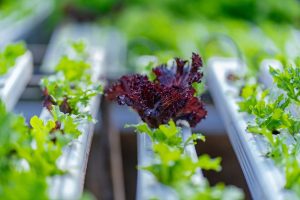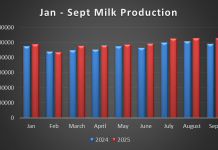
By Kovedzayi Takawira
It’s early morning in a wooden box office at Vitagrow Urban Farm in a leafy suburb of Harare, Zimbabwe. Co-founder and Managing Director Keith Chipudhla (34) and his accountant are busy with their morning routine: balancing books, finalizing orders, and preparing for the day’s deliveries.
The quiet hum of business is only interrupted by the rhythmic hissing of water coursing through pipes, a signature sound of a system that fuels their thriving enterprise.
From his matchbox office, Chipudhla can see rows of greenhouses that stretch across the backyard property.
Inside are different varieties of cucumbers, lettuce, and edible flowers that are well aligned and nurtured without soil but only sustained by nutrient-rich water.
The ever-fresh plants are destined for Harare’s upmarket supermarkets and restaurants.
Vitagrow Urban Farms is part of a growing movement in Zimbabwe embracing hydroponics, an innovative and water-efficient farming method reshaping agriculture in urban and peri-urban spaces.
According to Edengreen, Hydroponics is a plant-growing method that substitutes water for soil, while the Journal of Soil and Water Conservation says the system is gaining popularity all over the world because of its efficient resource management and quality food production. And further describes this as the best method since soil-based agriculture is now facing various challenges such as urbanization, natural disasters, climate change, and indiscriminate use of chemicals, and pesticides which are depleting land fertility.

In the first two years, nothing was growing at Vitagrow as Chipudhla counted losses and mistakes till he came across Ms Mukarati’s 160 Hydrofarm.
“Straight from university in China with no agriculture background, I decided to make use of my parents’ backyard garden and incurred losses till I came across hydroponics through 160 Hydro farm and got mentorship.”
Soil diseases and chemical overuse ruined his earlier venture into traditional farming.
“Before hydroponics, I once had a cabin full of pesticides that were meant to fight soil disease. I would consult different agronomists, and they would recommend one pesticide after another. This was expensive and unsustainable,” he said
According to ScienceDirect, Hydroponics is the practice of growing plants in a nutrient-rich solution without a soil substrate to provide physical support. This then helps or substitutes the risk of getting one’s plants affected by soil-borne diseases.
In Zimbabwe, land is not accessible to many, especially the youth; it is usually distributed along political lines, making it beyond the reach of many
“In my parents’ backyard, there was only 500 m2, half the area where Vitagrow is now. I needed to make a profit and a living out of it, hydroponics became the game changer since I could have more plants in a small piece of land compared to the ground farming,” he says
Agronomist Desire Tavengwa from Hurudza Agro-consultancy echoes the value of hydroponics for urban farming.
“This is the best method for urban farming since the plants can be stacked vertically, making the technology even more ideal for rooftops, balconies, and backyards.”
One greenhouse at Vitagrow can accommodate more than 3,000 plants of lettuce at once
Due to climate change, Zimbabwe has been receiving little rainfall, and this has become a challenge for most farmers. Those in urban centers are not being spared either, most of whom have drilled boreholes that dry before the next rainy season.
“Back at my parents’ place I tried to drill a borehole but it would run dry faster than I anticipated and you would find that crops wouldn’t be ready for market on the other side the rains were not coming at all, and sinking the borehole every season wasn’t a choice,” said Chipudhla counting his losses
Agronomist Tavengwa explains that hydroponics uses up to 90% less water compared to traditional farming methods.
“Comparing the system to ground farming the hydroponic uses about 90 to 95 percent less water since it will be recycled from time to time, and this is crucial in the sense that in Zimbabwe we already have a water shortage, especially in urban areas where we don’t have enough water even for peoples to consume,” said the Agronomist
At Vitagrow, a single one-thousand-liter tank can supply one greenhouse with 3,500 plants for 4 to 5 days before it needs a refill
“Usually if you go ask agronomists they will tell you that if you are to plant cabbages in your farm you are likely to get more than 6000 heads from your seeds but they do not factor in diseases at all of which what I have discovered is there no need to count your eggs before they hatch when doing ground farming because there are about 60% chances that your crops might reach maturity and go for the market, so imagine the 40% loss that is huge, whereas with hydroponics the probability is above 90% with lesser costs and time and the quality will also be good you can compete within the market,” said Chipudhla
Tavengwa says that plants in hydroponics grow faster than those on the ground.
“The growth rate in a hydroponic system is faster compared to the ground. You can find a plant that normally needs 6 weeks to mature in conventional farming, taking up 4 to 5 weeks in this technology,” said Tavengwa
“For me, this is a do-or-die situation. I live and breathe hydroponics. I stay less than 15 meters from the garden. This is no longer just a project but a business.”
“If you are a city boy like me, this system is the best. You can wear a suit and come to the garden and still walk out looking fresh and clean; nothing will make you dirty here. This is smart farming,” said Chipudhla
The mindset shift from projects to enterprise is what he credits for Vitagrow’s growth.
“In the last five years, we had to learn fast and run it as a business. TV interviews and photo ops don’t sustain you. Even during tough times, we had a team (my accountant, a guy with a biotechnology degree, and another one who is trained in water management). We learn from each other to solve problems, and we invest much in research, more than anything, and experiment a lot,” he said
As part of their move to reduce crops, Vitagrow is on the move to eliminate greenhouses.
“So we are trying to eliminate the greenhouses by trying other varieties in the open air; with some, we are winning, but some are losing. The main aim is to reduce the cost of setting up the whole system,” said Chipudhla
Vitagrow offers training programs, particularly targeting young people and students. However, Chipudhla has observed a major barrier to growth: start-up capital.
“After training, we give quotes for setting up systems, but only a few people follow through. Many fear investing in something that’s not widely known. That’s why we have started taking training into schools. The hope lies in the next generation, which understands and embraces new technologies better,” he said
Chipudhla was lucky to have investors from the diaspora and a local company that partnered with him and has invested close 100,000 USD in the last five years, for which he has managed to make a profit in the last 2 years.
He goes on to clarify that hydroponics isn’t here to replace traditional farming.
“It’s not a replacement. It’s an improvement. Especially in the face of climate change, hydroponics offers a sustainable method that can ease the burden on conventional agriculture,” he adds as he signs off on the first delivery of the day.
The delivery is made using an electric three-wheeler bike, another nod to Vitagrow’s environmentally conscious ethos.
Vitagrow’s dream is to become a one-stop shop that can provide knowledge, sell equipment, and set up a market where one can take their product straight from the pipes.
“Imagine harvesting your lettuce straight from the pipe and taking it home; that’s the dream. We want to lead the industry and be part of the entire value chain,” said Chipudhla
With limited, recurring drought and rising input costs, hydroponics is emerging as a viable alternative for urban farmers in the country.
For Chipudhla, it has turned a struggling backyard venture into a profitable agribusiness. While challenges like high startup costs remain, he believes the future lies in equipping the next generation with the knowledge and tools to adopt more sustainable farming methods. As Vitagrow hopes to play a central role in shaping Zimbabwe’s urban agriculture landscape











